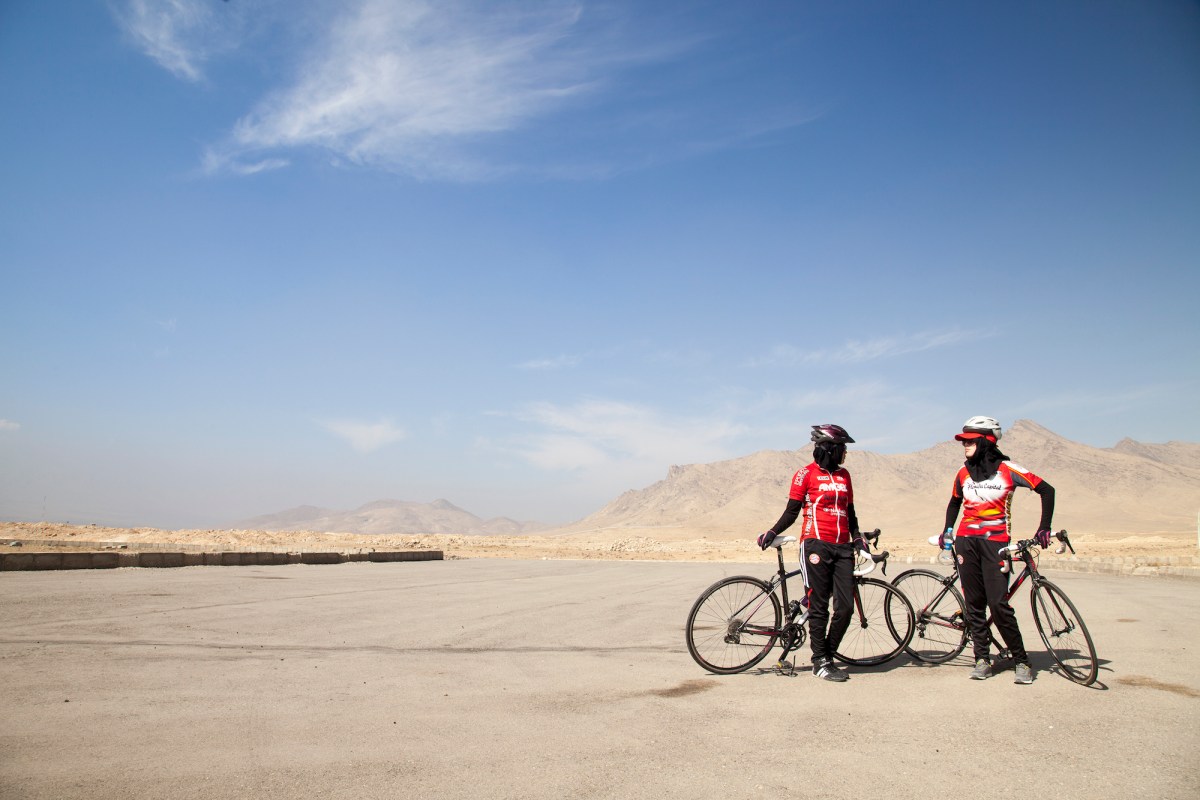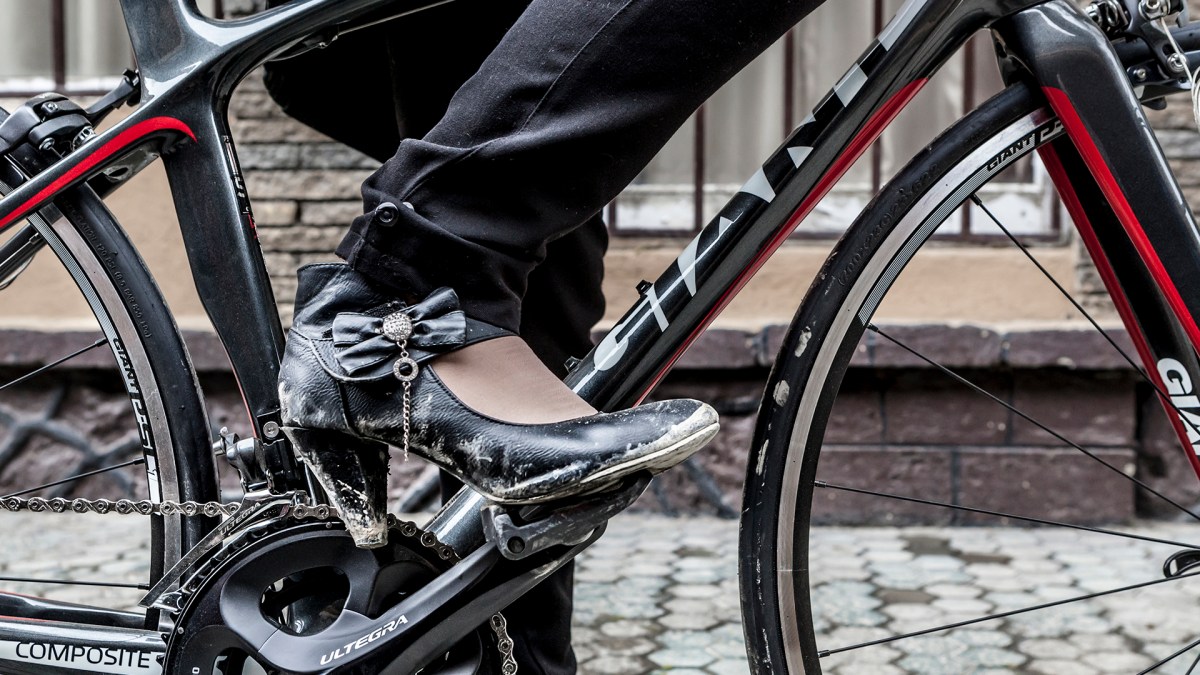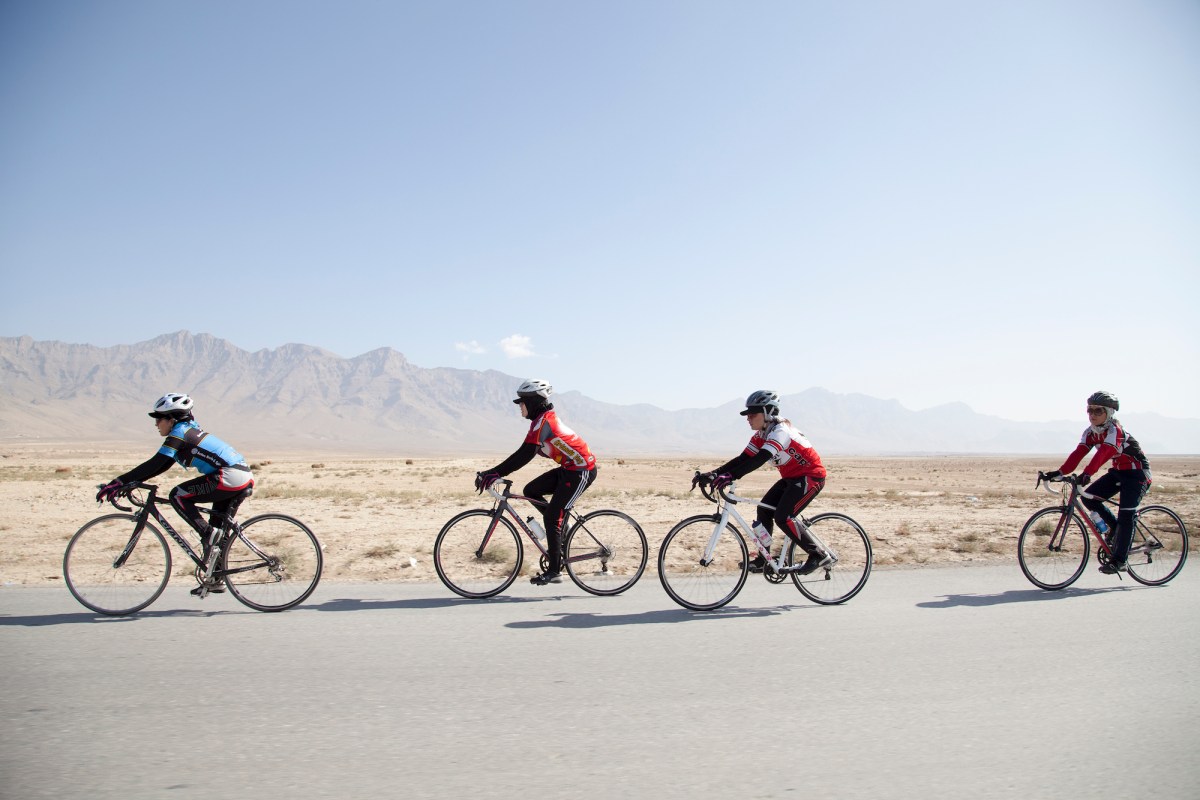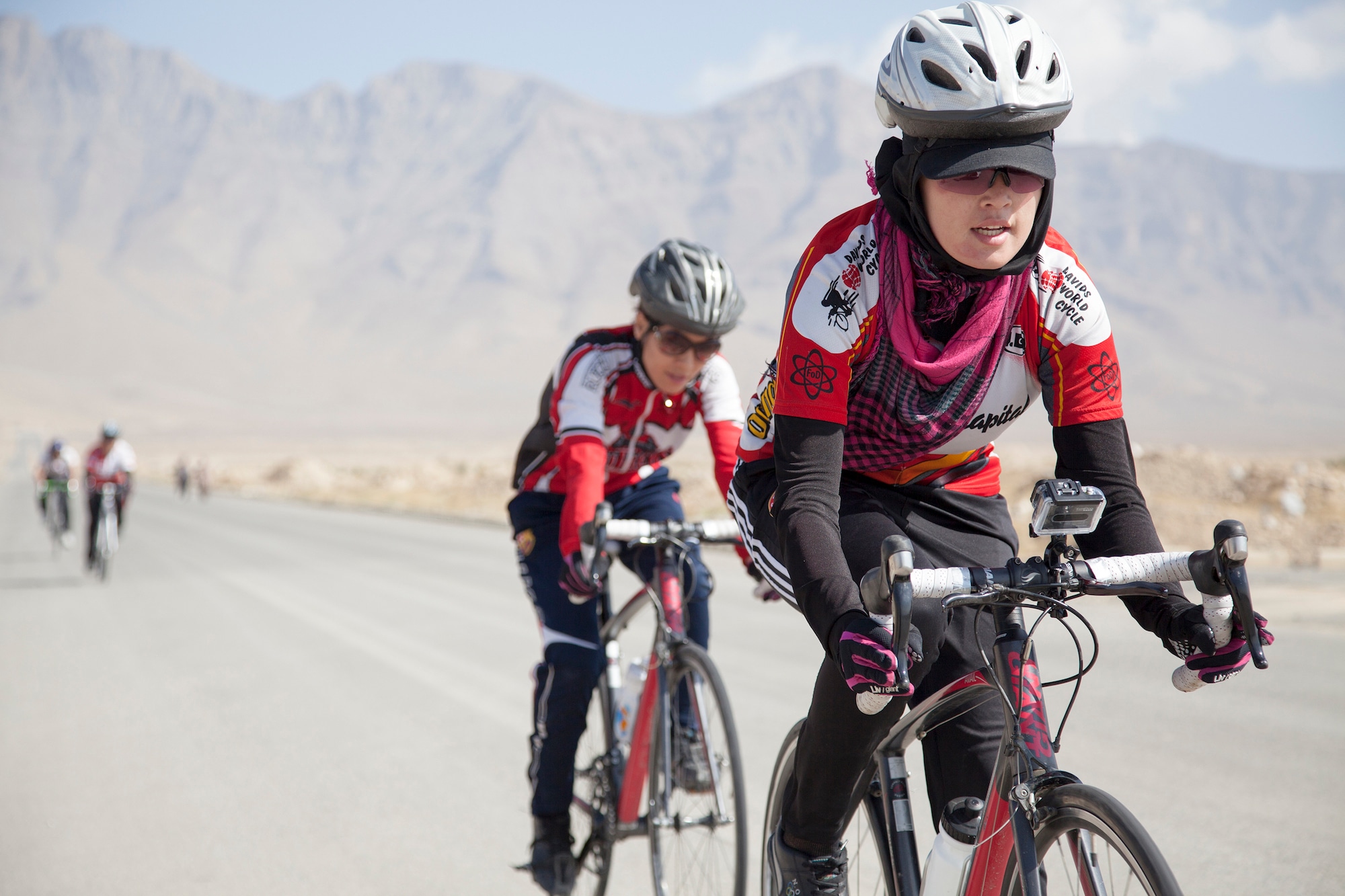Relatively affordable, safe and efficient, bicycles have long played a key role in movements for women’s equality, starting with the American suffragettes in the late 19th century.
“Let me tell you what I think of bicycling,” said Susan B. Anthony, the famous women’s rights activist, in 1896. “I think it has done more to emancipate women than anything else in the world. I stand and rejoice every time I see a woman ride by on a wheel.”
More than a century later, the bicycle continues to grant women across the world new, hard-fought freedoms and independence. This is the subject tackled by a new documentary, Afghan Cycles, which premiered this past spring at the Canadian film festival, Hot Docs, and will be touring through the United States this fall.
Five years in the making, director Sarah Menzies embedded herself with the cyclists on the Afghan Women’s National Cycling Team to tell a story about passion and adversity. The narrative is driven mostly by interviews with the athletes and their coaches, and they portray a stark, authentic picture of what it is like for a woman in Afghanistan to ride a bike. Menzies filmed the women during their prayers and when they get ready to ride their bikes. They tie head scarves under the helmets and wear long-sleeve bike uniforms, even in the desert heat, to stay covered. Midway through the film, Afghan Cycles documents escalating tensions and instability in Afghanistan, which Menzies says troubled the team and made them feel more at risk of violence. Still, the athletes remained determined to speed down a road and compete in races. Menzies honed in on the story of one team member in particular, Frozan, who flees Afghanistan and seeks asylum in France.
This is Menzies’ first feature-length documentary. She grew up in the Pacific Northwest and has a portfolio of character-driven, outdoor films, including The Mirnavator and A Steelhead Quest. When Shannon Galpin, the founder of the advocacy nonprofit Mountain2Mountain and a producer on the film, told Menzies about the Afghan Women’s National Cycling Team, she thought it would be a short project. For initial funding, the Seattle-based filmmaker raised money on Kickstarter. But, not long after she arrived, she saw the scope and potential to make a feature-length film. “I realized very quickly that we needed to do a much deeper dive, to have the impact I wanted, to be able to learn who these women were and what they were up against,” Menzies says.
We recently spoke with Menzies to learn more about the documentary and how bicycles continue to empower women in Afghanistan.
Editor’s note: This interview has been edited for length and clarity.
Tell us about the first time you went to Afghanistan and met the athletes on the women’s cycling team. What was going on in the country at that time?
That was 2013. We were there that spring. Kabul, at that time, was a lot safer than what was coming out in the news. Sure, there were attacks happening in the city here and there, but things have gotten a lot worse. When I think back on 2013, it was just a lot safer. Restaurants and cafés were open. There were a lot more guest houses open. Over the course of the last five years, so much of that has [seemed to] shut down because people have been leaving. It’s changed a lot.
I think because I was friends with Shannon [Galpin] and she had worked there for so many years, I felt like I was going there with good support and people I could trust. And then from there, I built out a team on the ground, so when I would land and go back after that initial trip, I had people there who I trusted.
When did you meet the women?
We landed at the airport on our very first trip and met up at the coach’s offices, where we met a couple of women who were there, waiting to meet us. I remember sitting across from three of them. We couldn’t communicate other than little smiles and funny faces. But we had our interpreter there to keep the conversation going. I remember just looking at them and they locked eyes with me, too. I was thinking, ‘Wow, these women are so strong.’
Any image of victim or suppression, all of that disappeared as I saw these three strong women looking at me. That was a powerful moment for me where I realized, this is important. I hadn’t even seen them ride yet or had a personal conversation with them. There was just something so striking about that [memory].
I always did sports growing up, so there was this recognition. Granted, I didn’t have the same hurdles as they do, but I saw a little bit of myself, in some way, in them. Hopefully, they felt that way, too. Even though we grew up in completely different areas and backgrounds, at the core, maybe we were more similar than we thought.
Women riding bikes is already controversial in Afghanistan. Competing put these athletes in the center of that controversy. Did it take time to develop and earn the team’s trust?
Yeah. I always say it was difficult to shoot in a country like Afghanistan. It was difficult to get money and get [the project] funded. But ultimately, at the end of the day, the hardest part was the lack of communication. We needed a translator. It was important to me that this be a character-driven film, and to have them tell the story, not me as a narrator. So, it’s hard when you have to go through a translator and conversations are five times longer than they should be because of all the back-and-forth.
Our first conversations were about our goals for the film, and every time I’d go back, we’d talk about that again to make sure, from a security standpoint, they were feeling good about it. They all understood the power that this could have and that, by sharing their story, they could inspire more women to ride. They could change their culture in Afghanistan. They could change the culture in other Muslim countries that face the same kind of [oppression], where women on bikes are controversial. They got it, even though they were young. They were teenagers at that point.

Photo Credit: Jenny Nichols
Five years is a long time. What kept you moving forward with the project?
There were plenty of times when I thought we were going to pull the plug on it, or it just wasn’t working. But ultimately, I felt I had made a promise to these women, spoken or unspoken. I gained their trust and I said I was making this movie. So, one way or another, we were going to get it done. But it wasn’t always easy, that’s for sure.
Your film illustrates how empowering a bicycle can be for someone. Can you elaborate on the impact a bicycle can give a woman in a place like Afghanistan?
To start, when you really ask people, ‘Why is this controversial?’ they’d say things like, ‘It goes against our traditions.’ Or, ‘Women just don’t do that.’ You’d hear these blanket statements. But my own personal opinion is simply that bikes give freedom and independence to someone.
Bikes are all over that country. Boys ride them everywhere because it is an affordable vehicle that can get you around faster. But for women, you’re just not seeing it.
A woman on a bike doesn’t need to rely on anyone else. They can get to where they want to get to, freely. That was something I was really drawn to. It was cool to hear about the national team and their competitive goals. But beyond the competitive goals, there is also cultural change. That’s what they talk about, too: ‘Why can’t I ride a bike like a boy?’ To hear them talk about getting to school safer, running errands more efficiently, get out of a bad situation faster—a bicycle provides all of that.
This isn’t just a problem in Afghanistan. There are groups in the United States that are trying to do the same thing and get at-risk youth and low-income kids on bikes. We’re trying to find those groups out there and connect with them. Whether it’s cycling or sports more broadly, we want to use this as a tool to encourage women to participate in sports.

Photo Credit: Claudia Lopez
What was it like for you, as a woman, to have a camera and be filming something so controversial?
That’s always a question people want to know. I had a great team on the ground. If anything, and this is where I feel like an ambassador for Afghanistan. We’d get groups mobbing us out of interest. What are you doing? Who are you filming? Why are you here? I think that took some getting used to, and to not have your first thoughts be, I’m being threatened. They were just interested people who wanted to know who I was.
But I’d keep our crews really small. Typically, it’d just be me and one other shooter. And our fixer and a driver. I did that on purpose. These women are getting on bicycles. What they’re doing is so visible. They are already drawing in this attention and I wanted to be very conscious to not pull in extra attention beyond that.
In an interview with the Human Rights Watch, you set up a question in your film: Is this a high point for women’s rights in Afghanistan? What’s the answer to that question.
[The Human Rights Watch] has that line that I think is so important in the film. Is this as good as it’s going to get? Or are things going to start moving backward and are we going to lose all that we’ve gained in the last few years? That’s what’s so interesting. All we really hear about Afghanistan is the war-torn stuff. But you forget that, at one point, Kabul was where the East met the West. … You look at photos and think [the Afghan women in the ’80s] could pass as Western women. They could be photos from the ’60s in America.

Photo Credit: Jenny Nichols
Pushing this film right now seems really timely, given the conversation about immigration that’s playing out at a national and global level. What has that experience been like?
From the beginning, we knew that this would be a heavy story. But we also wanted it to feel positive, despite the risks. It was important to me that this still painted a positive light on Afghanistan. Having the Taliban and ISIS there, that part is very real. But there’s a whole country there and [many] live their lives in fear that they could be in the wrong place at the wrong time, just trying to get to work. Despite all of that, they’re so resilient and they’re hilarious. Everyone there is so funny. They still find the joy. And honestly, I feel lucky to have traveled as much as I have. Afghanistan goes down as one of the most welcoming places I’ve ever been. The women and their families really took me in right away. Those were all things I wanted to make sure came across.
I loved the scene when, after the race, they take their bikes down to the river and eat potatoes. It was heartwarming and reminded me of a universal feeling that comes when you are outside, after a long day of activity, with your friends. You did such a great job balancing intense moments with scenes like this. At the end of film, what do you hope audiences walk away with?
I hope this film can get people to look at the bicycle differently and see that it’s more than a sport or something fun to do. That it’s actually providing freedom and independence for women in Afghanistan.
I hope that humanizing these young, Muslim women will help people think differently about a foreigner coming into their country. Oftentimes, they are sacrificing a lot to make that trip and they’re hoping for a better future than what they’d have back home.
And I hope it culminates into this portrait of Afghanistan beyond a war-torn country. That it also shows who these people are on a more intimate and personal level.
“Afghan Cycles” will be touring film festivals and cities across North America throughout the rest of the year. To learn more about the film and where you can see it, visit their website.
